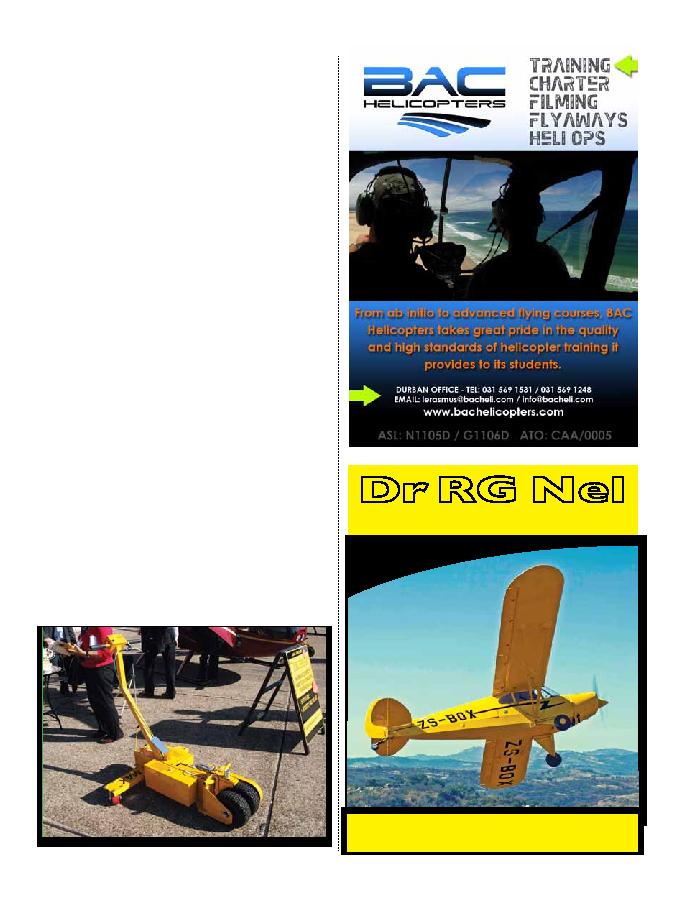
2013 FEBRUARY / Vol. 5 / No. 2 /
GA
43
way, J B Knowles Inc's Chopper
Spotter, made in Wisconsin, USA,
has two `yokes' which you attach to
the helicopter; then you press `up'
on a hand held control. This lifts
the helicopter off the ground, and it
can thus be easily moved to its new
position. Like Helilift, Chopper
Spotter will only work on hard
surfaces, and, also like Helilift, one
machine will work for virtually any
size of helicopter. But there are one or
two slight but significant differences
between Chopper Spotter and Helilift.
Chopper Spotter attaches to and
lifts the helicopter from the ground
handling wheel attachment points
rather than attaching anything to
the skids. The company claims that
this is safer and less likely to cause
damage. But Chopper Spotter can
only be used from the rear of the
helicopter, whereas Helilift (and also
the Mototok Helimo) can be used
from the front also if required.
Based in Quebec, Canada,
Helitowcart make a number of
helicopter towing carts for different
sized helicopters. Their smaller lifting
solutions, termed `Helitowcarts',
require the use of the helicopter's own
wheels, and work a little like Robin
Aviation's Power Tow Cart. The
larger ones are called `Helicarriers'
and lift large helicopters in a similar
way to TLC's Helilift. However
there are some differences between
the two. Firstly, unlike the Helilift,
which can only operate on tarmac,
Helicarriers use pneumatic wheels
instead of hard ones, and will also
work on rough terrain and slopes.
They can even cope with snow, ice,
gravel, sand, and dirt, making them
almost all-terrain towing vehicles.
Nathalie Barbeau, Helitowcart's VP
for Commercial Affairs, emphasised,
"We are located in Eastern Canada
and have very rough weather here in
winter. So we designed our devices
so that they could be efficient even
when the tarmac is covered in clear
ice or snow". The Helicarriers also
lift helicopters very high up to
18cm off the ground, which means
that they do not get stuck on uneven
surfaces or rough terrain. Prices
of these different types of handling
equipment vary quite a bit, ranging
from $4,000 to $18,000 for the
simpler Helitowcarts, up to $22,000
to $30,000 for the larger Helicarriers.
But the number of different sizes and
types means that operators need only
buy and use the kind of system which
they actually need.
It might seem after all this that
there could be nothing completely
new in the field of helicopter handling
solutions. However, Idaho USA
based Heliwagon have come up with
something rather innovative. Their
`Heliwagon' is a remote controlled
helicopter landing dolly that provides
a flat platform on which you can land
your helicopter, and also a means
of then moving the platform and
helicopter together over the ground.
A remote control device means that
the operator can move the Heliwagon
from any point around the periphery
of helicopter, thereby providing great
visibility and flexibility. It can even
be operated from inside the cockpit.
I saw Heliwagon operated at the
Helitech trade show, and it looked
easy to operate and very effective.
I was assured that it could operate
in most situations, cope with rough
ground, and even clear low obstacles
if necessary. The landing platform is
battery operated, and is designed for
all light to medium helicopters.
With helicopters being used
increasingly in all parts of the world,
ground handling for the larger ones
looked set to remain a major problem
and a significant expense. Hopefully
that is now a thing of the past, and
it is fantastic to see that there are
now some viable and economically
priced solutions. ·
One of the simpler devices used for moving a Robinson R22 or R44.
Dr RG Nel
Simunuye Centre No. 10 - At Checkers Centre, Hazyview
Tel: 013 737 8779 Fax: 013 737 8866 Cel: 082 550 8975
MB.Ch.B (stell) Senior Aviation Medical
Examiner with CAA (MS080) Senior Aviation Medical Examiner
with FAA (03304)
·
Resting and Effort ECG
·
Respiratory Function
·
Test Visual performance
·
Profile Abdominal
·
Full Clinical Examination
·
Sona
r

